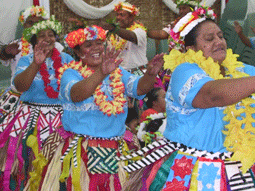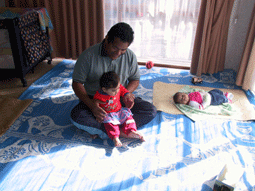 |

Tuvalu is Drowning
by Alexandra Berzon

Tuvaluans perform traditional song and dance - called fatele - in a West Auckland meeting hall. Photo: Durrell Dawson
It's the biggest party of the year on Nanumea, one of the nine islands that make up Tuvalu. It's the annual celebration of the day European missionaries brought Christianity to the island. Families gather on mats and feast picnic-style on foods like funafuna, donuts filled with jam, taro drenched in coconut milk, egg fu young, and buckets of KFC chicken. Then competing groups of elders and youth take turns dancing, singing and drumming on a big wooden box into the early hours of the morning.
Tuvaluans have been performing these songs for generations, across their string of low coral atolls. But this event is not taking place in Tuvalu. Instead, we're 2,000 miles away in Auckland, New Zealand. And here, surrounded by tradition, sits a group of young girls looking unimpressed. One of the girls sings her favorite song, "My Humps" by the Black Eyed Peas.
Here in this West Auckland suburb where many Tuvaluans have settled, you won't find an ocean outside the door, coconut trees on the shore or taro in every garden. You're more likely to encounter malls and wide boulevards. Over the last decade, the islanders have come here for many reasons - better jobs, college, overcrowding on the islands - and to escape what many see as a threat of sea level rise caused by global warming.
Penisita Taniela arrived in New Zealand with a small suitcase and a carton of fish. He lives now in the western working-class suburb Ranui in a three-bedroom home with his wife, children, father, stepmother, and sisters.
Peni's living room, like most Tuvaluan homes, contains no furniture - just hand-woven straw mats that his father and step-mom sleep on. Shell necklaces and family photos line the walls. As Peni fries pancakes on a leisurely Saturday morning, his two young kids ride around the living room on a shiny new bike with a squawk box.
Nearly 20 years ago, when Peni was just a teenager living on his family's land, he remembers hearing that some day the sea would rise and drown his island.

Telaki Taniela plays with his grandaughter in his living room, while his youngest child looks on. Photo: Durrell Dawson
"Just my dad said, 'Oh, don't worry about that. We are just waiting for many years.' Not, not now," says Peni.
But over time, Peni and his family noticed changes - high tides getting higher, beaches eroding, water coming up through the soil.
"As a kid we used to play on the beach," says Peni's father, Telaki Taniela. "We see the high tide and all that but in recent years high tide gone over beyond what it used to be. I said to myself, 'Yes, the scientists are really telling the truth.' I managed to build two houses there. I just got up and go and left it behind to my family there. I don't want to get up in the morning and find myself under water."
Gauges in Tuvalu indicate the sea has risen an average of five and a half milliliters per year in recent years. That's consistent with average worldwide sea level rise. The greater worry, though, is for the future. The Intergovernmental Panel on Climate Change, which represents the consensus of 2,000 scientists, predicts that over the next 50 to 100 years, global warming will cause oceans to rise up to three feet, and possibly much higher depending on the melting of the Antarctic and Greenland ice sheets. Tuvalu, along with a handful of other islands, is particularly vulnerable, because its islands are low-lying and narrow, no more than 3-feet high in many spots.
After breakfast, Peni squats in front of his 12-inch television and searches through piles of old VHS tapes. He inserts a video his father took years ago of a dance performance in Tuvalu and stares at the screen. His one and two-year-olds bang on their bike in time with the drummers from the island.
"I show my kid that movie from Tuvalu," says Pani, "and say, 'Ohhhh, Tuvalu, Tuvalu, where is Tuvalu?' They don't know where is Tuvalu. And say, maybe they will go there one time. Maybe one day we go there and see the island."
Back to Reports from a Warming Planet